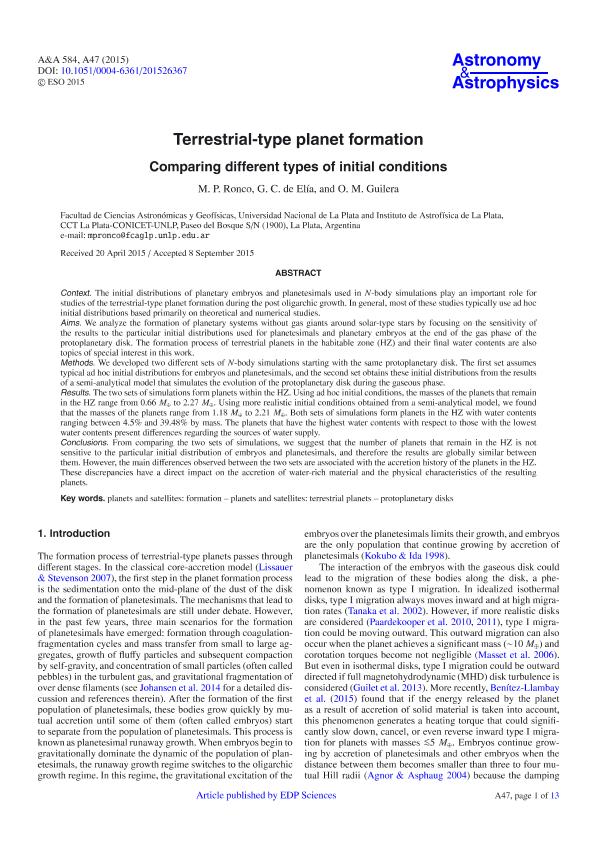Mostrar el registro sencillo del ítem
dc.contributor.author
Ronco, María Paula

dc.contributor.author
de Elia, Gonzalo Carlos

dc.contributor.author
Guilera, Octavio Miguel

dc.date.available
2017-03-13T19:11:26Z
dc.date.issued
2015-12
dc.identifier.citation
Ronco, María Paula; de Elia, Gonzalo Carlos; Guilera, Octavio Miguel; Terrestrial-type planet formation. Comparing different types of initial conditions; Edp Sciences; Astronomy And Astrophysics; 584; 47; 12-2015; 1-13
dc.identifier.issn
0004-6361
dc.identifier.uri
http://hdl.handle.net/11336/13780
dc.description.abstract
Context. The initial distributions of planetary embryos and planetesimals used in N-body simulations play an important role for studies of the terrestrial-type planet formation during the post oligarchic growth. In general, most of these studies typically use ad hoc initial distributions based primarily on theoretical and numerical studies.
Aims. We analyze the formation of planetary systems without gas giants around solar-type stars by focusing on the sensitivity of the results to the particular initial distributions used for planetesimals and planetary embryos at the end of the gas phase of the protoplanetary disk. The formation process of terrestrial planets in the habitable zone (HZ) and their final water contents are also topics of special interest in this work.
Methods. We developed two different sets of N-body simulations starting with the same protoplanetary disk. The first set assumes typical ad hoc initial distributions for embryos and planetesimals, and the second set obtains these initial distributions from the results of a semi-analytical model that simulates the evolution of the protoplanetary disk during the gaseous phase.
Results. The two sets of simulations form planets within the HZ. Using ad hoc initial conditions, the masses of the planets that remain in the HZ range from 0.66 M⊕ to 2.27 M⊕. Using more realistic initial conditions obtained from a semi-analytical model, we found that the masses of the planets range from 1.18 M⊕ to 2.21 M⊕. Both sets of simulations form planets in the HZ with water contents ranging between 4.5% and 39.48% by mass. The planets that have the highest water contents with respect to those with the lowest water contents present differences regarding the sources of water supply.
Conclusions. From comparing the two sets of simulations, we suggest that the number of planets that remain in the HZ is not sensitive to the particular initial distribution of embryos and planetesimals, and therefore the results are globally similar between them. However, the main differences observed between the two sets are associated with the accretion history of the planets in the HZ. These discrepancies have a direct impact on the accretion of water-rich material and the physical characteristics of the resulting planets.
dc.format
application/pdf
dc.language.iso
eng
dc.publisher
Edp Sciences

dc.rights
info:eu-repo/semantics/openAccess
dc.rights.uri
https://creativecommons.org/licenses/by-nc-sa/2.5/ar/
dc.subject
Astrobiology
dc.subject
Numerical Methods
dc.subject
Protoplanetary Disks
dc.subject
Planets Formation
dc.subject.classification
Astronomía

dc.subject.classification
Ciencias Físicas

dc.subject.classification
CIENCIAS NATURALES Y EXACTAS

dc.title
Terrestrial-type planet formation. Comparing different types of initial conditions
dc.type
info:eu-repo/semantics/article
dc.type
info:ar-repo/semantics/artículo
dc.type
info:eu-repo/semantics/publishedVersion
dc.date.updated
2017-03-07T15:21:15Z
dc.journal.volume
584
dc.journal.number
47
dc.journal.pagination
1-13
dc.journal.pais
Francia

dc.journal.ciudad
Paris
dc.description.fil
Fil: Ronco, María Paula. Consejo Nacional de Investigaciones Científicas y Técnicas. Centro Científico Tecnológico la Plata. Instituto de Astrofísica de la Plata; Argentina
dc.description.fil
Fil: de Elia, Gonzalo Carlos. Universidad Nacional de la Plata. Facultad de Ciencias Astronómicas y Geofísicas; Argentina
dc.description.fil
Fil: Guilera, Octavio Miguel. Universidad Nacional de la Plata. Facultad de Ciencias Astronómicas y Geofísicas; Argentina
dc.journal.title
Astronomy And Astrophysics

dc.relation.alternativeid
info:eu-repo/semantics/altIdentifier/doi/http://dx.doi.org/10.1051/0004-6361/201526367
dc.relation.alternativeid
info:eu-repo/semantics/altIdentifier/url/http://www.aanda.org/articles/aa/abs/2015/12/aa26367-15/aa26367-15.html
Archivos asociados
